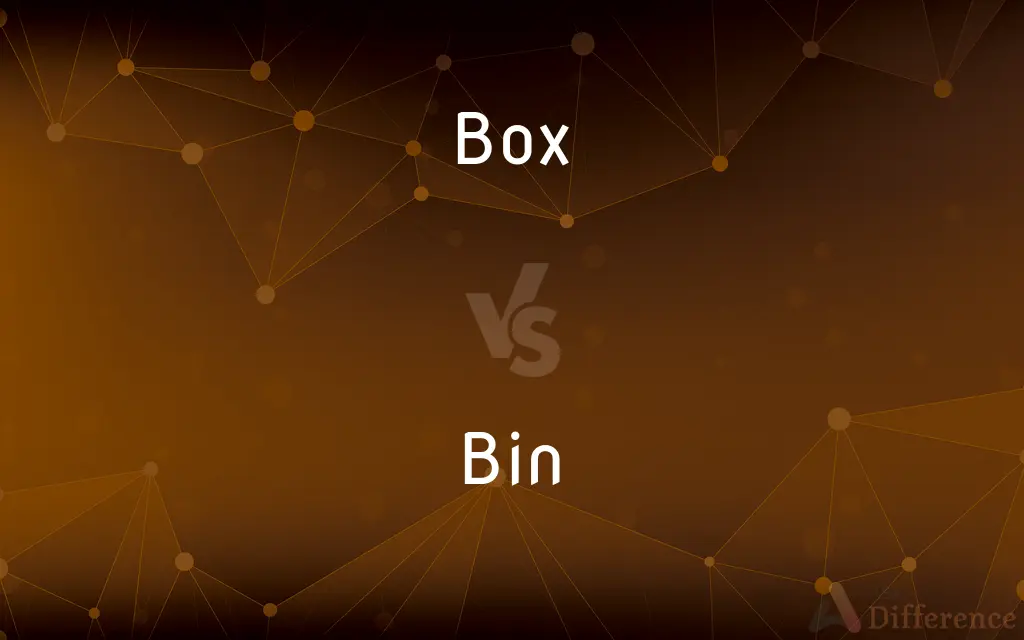Box vs. Bin — What's the Difference?
By Tayyaba Rehman & Maham Liaqat — Updated on March 1, 2024
A box is typically a rigid container with a rectangular shape, used for storing or transporting items. A bin is a container used for holding or organizing goods, often without a specific shape requirement and may have an open top.

Difference Between Box and Bin
Table of Contents
ADVERTISEMENT
Key Differences
Boxes are often made from materials like cardboard, wood, or plastic, designed to protect their contents from damage. They come in various sizes and can be sealed using lids, tape, or other closures. Bins, on the other hand, are more flexible in terms of materials and design. They can be made of fabric, metal, plastic, or even woven materials, and their shapes vary from cylindrical to rectangular or irregular.
Boxes are commonly used for packaging, shipping, and storing a wide range of items, from small electronics to large household goods. Their shape and structure make them ideal for stacking and handling. Bins are typically used for sorting and organizing items, such as recycling bins, laundry bins, or storage bins for toys or tools. They are often open-topped for easy access and are not usually designed for transport.
Boxes are primarily used for the containment and protection of items, especially during transport, bins are geared towards organization and accessibility within homes, workplaces, or public spaces. Boxes tend to be temporary or single-use, particularly cardboard ones, whereas bins are more likely to be used repeatedly over a longer period.
The choice between a box and a bin depends on the intended use. For moving or shipping items, a sturdy box is preferred for its protective qualities. For organizing items within a space, a bin might be more appropriate due to its accessibility and durability.
Boxes and bins serve different purposes in the storage and organization of items. Boxes are best suited for securing items, especially for transport, while bins are ideal for categorizing and accessing items in a stationary setting.
ADVERTISEMENT
Comparison Chart
Material
Cardboard, wood, plastic
Fabric, metal, plastic, woven materials
Shape
Typically rectangular
Varies (cylindrical, rectangular, irregular)
Top
Often closed with a lid or tape
Often open for easy access
Purpose
Storing, transporting
Organizing, holding
Usage
Single-use or reusable for a limited time
Reusable and durable for long-term use
Compare with Definitions
Box
Plastic storage box.
She organized her seasonal clothes in clear plastic boxes.
Bin
Waste bin.
Discard your trash in the waste bin under the sink.
Box
Wooden crate.
Fruits are often transported in wooden boxes to prevent damage.
Bin
Laundry bin.
Dirty clothes should be put in the laundry bin.
Box
Gift box.
The present was wrapped in a beautiful gift box.
Bin
Storage bin.
Tools are kept organized in labeled storage bins in the garage.
Box
A box (plural: boxes) is a type of container or rectangular prism used for the storage or transportation of its contents. The size of a box may vary, from the very smallest (such as a matchbox) to the size of a large appliance, and can be used for a variety of purposes ranging from the functional to the decorative.
Bin
Compost bin.
Kitchen scraps are collected in a compost bin for the garden.
Box
Cardboard shipping box.
The package was delivered in a sturdy cardboard box.
Bin
A container or enclosed space for storage.
Box
Shoe box.
New shoes come packaged in a branded shoe box.
Bin
To place or store in a bin.
Box
A container with a flat base and sides, typically square or rectangular and having a lid
A hat box
A cigarette box
Bin
A container for rubbish or waste.
A rubbish bin
A wastepaper bin
An ashes bin
Box
An area on a page that is to be filled in or that contains separate printed matter
Tick the box on the coupon
Bin
Any of the fixed-size chunks into which airspace is divided for the purposes of radar.
Box
A separate section or enclosed area reserved for a group of people in a theatre or sports ground, or for witnesses or the jury in a law court
The royal box
Bin
A box, frame, crib, or inclosed place, used as a receptacle for any commodity; as, a corn bin; a wine bin; a coal bin.
Box
A small rectangular shelter.
Bin
The quantity contained in a bin
Box
(rail) signal box
Bin
Store in bins
Box
A rectangle: an oblong or a square.
Place a tick in the box.
This text would stand out better if we put it in a coloured box.
Bin
Recycling bin.
Please sort the recyclables into the correct bin.
Box
Separate partitioned area in a public place for a few people;
The sentry stayed in his box to avoid the cold
Box
A blow with the hand (usually on the ear);
I gave him a good box on the ear
Box
Put into a box;
Box the gift, please
Box
Engage in a boxing match
Common Curiosities
Can boxes be used for organizing like bins?
While not as common, boxes can be repurposed for organizing, though bins are often more practical due to their durability and design for easy access.
Why are boxes preferred for shipping?
Boxes provide better protection against damage and are easier to stack and handle during transport compared to bins.
How do material choices affect the use of boxes and bins?
The material affects durability, weight, and protection. For example, cardboard boxes are lightweight but less durable than plastic bins.
Can bins be sealed like boxes?
Some bins come with lids or covers, allowing them to be sealed, though they are typically designed for easy access rather than secure sealing.
Are bins more environmentally friendly than boxes?
Bins, being reusable and durable, can be more environmentally friendly than single-use boxes, though reusable boxes also exist.
Are there bins specifically designed for outdoor use?
Yes, many bins are designed for outdoor use, made from materials that withstand weather conditions, like heavy-duty plastics or metals.
How does the design of boxes and bins impact their functionality?
The design, including shape and material, directly impacts their functionality—boxes are designed for protection and transport, while bins are designed for accessibility and organization.
Can boxes be customized more easily than bins?
Boxes, especially cardboard ones, can be easily customized with printing and branding, making them popular for product packaging.
Is there a significant cost difference between boxes and bins?
The cost can vary widely depending on the material and design. Generally, durable bins may cost more upfront but are more cost-effective over time due to their reusability.
Can both boxes and bins be recycled?
Yes, both can be recycled, depending on their material composition, though recycling guidelines vary by location.
Share Your Discovery

Previous Comparison
Blast vs. Explosion
Next Comparison
Travel vs. CommuteAuthor Spotlight
Written by
Tayyaba RehmanTayyaba Rehman is a distinguished writer, currently serving as a primary contributor to askdifference.com. As a researcher in semantics and etymology, Tayyaba's passion for the complexity of languages and their distinctions has found a perfect home on the platform. Tayyaba delves into the intricacies of language, distinguishing between commonly confused words and phrases, thereby providing clarity for readers worldwide.
Co-written by
Maham Liaqat















































